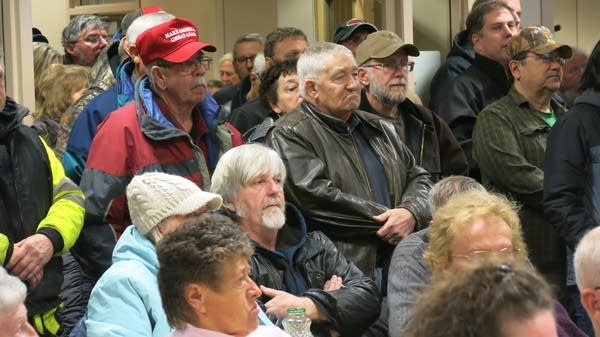Amid the chaos, Minnesota counties say ‘yea’ or ‘nay’ to refugees
What you need to know as local governments scramble to comply with Trump order

Go Deeper.
Create an account or log in to save stories.
Like this?
Thanks for liking this story! We have added it to a list of your favorite stories.
An executive order on refugee resettlement that was issued by President Trump in September is causing confusion, and some controversy, around the state as county boards scramble to figure out what actions they need to take.
Beltrami County made national news this week by becoming the first county in Minnesota, and possibly among the first in the country, to prohibit refugee resettlement within its borders. At least 18 other Minnesota county boards have made the opposite call, and declared that refugees can be resettled in their counties. Other counties have yet to schedule hearings on the issue.
Here’s a quick summary of what’s been happening around the state on this issue.
Why are we seeing counties weighing in on refugee resettlement right now?
Much of the uproar about refugee resettlement is the result of an executive order issued by President Trump in September. The order changed how the country’s refugee resettlement system has worked by requiring states and counties opt in if they want to allow refugees to be settled in their counties. If counties don’t take action by the time the order goes into effect in June, they’ll be considered a “no” vote on refugee resettlement.
Turn Up Your Support
MPR News helps you turn down the noise and build shared understanding. Turn up your support for this public resource and keep trusted journalism accessible to all.
Further confusing matters, groups that resettle refugees are facing an earlier deadline of Jan. 21 to submit applications for funding to help settle refugees. They’ve been urging the 25 counties in the state where refugees are mostly resettled to take action on the issue.
It’s worth noting that the executive order pertains only to primary resettlement. Once refugees are settled, they can relocate to any county they’d like, although they may lose federal benefits and support services.
Why did Beltrami County oppose allowing refugee resettlement?
It was largely a symbolic 3-2 vote by the Beltrami County Board of Commissioners on Tuesday night. No refugees have been directly settled in the county in the last five years. Some argue that refugees might tax county social services and budgets. Commissioners critical of allowing refugees in other counties also said they were concerned that there wasn’t enough information on the process to make a decision yet.
Almost 20 Minnesota counties have already said they support refugee resettlement. What are their arguments?
Some supporters have argued that giving refuge to people fleeing war or persecution is a humanitarian act. They’ve also pointed to the politicization of refugees, arguing that the president’s executive order divides communities.
The Nobles County board voted unanimously to allow refugee resettle in the county on Tuesday. Commissioner Matt Widboom said they studied the issue and decided that it didn’t make sense to essentially deny federal benefits to refugees who may move to the county anyway to join family.
”These are the folks that are fleeing their homeland and have no safe place to go,” Widboom said. “We’ve heard countless stories just from Nobles County that have spent years in camps away from their family and their homeland and looking for a safe place.”
Why do Minnesota counties seem to be taking such different approaches to the issue?
The president’s order was a surprise, and counties in the state didn’t get guidance about what their role might be until around Thanksgiving, according to Matt Hilgart, of the Association of Minnesota Counties. That guidance is not clear about who, when or how county boards should weigh in.
Some county boards have decided they need to vote up or down on the issue. Others have designated a county administrator to draft a letter saying the county will allow immigration. Many counties in the state, including some that have traditionally become home to refugees, have not yet scheduled a hearing on the issue.
County officials are understandably confused. Matt Hilgart, of the Association of Minnesota Counties said he’s been getting two or three calls a day on refugee resettlement since Thanksgiving: “Our efforts as an association were just to try to get as much information and education out to folks as possible. To educate them about the process for refugee resettlement, what it means, what are Minnesota statistics, to take questions, to rebut myths.”
What is the procedure for refugees to be resettled in the United States?
Refugees fleeing war or persecution go through an extensive vetting process that can take years before they can come to the United States.
After the United Nations grants them refugee status, their backgrounds are examined by U.S. Department of Homeland Security and FBI personnel. Refugees from some countries undergo additional scrutiny.
Refugees also receive extensive health screenings and cultural orientations before they’re matched with a resettlement group that helps find a place for them to safely settle.
What has refugee resettlement traditionally looked like in Minnesota?
Minnesota has a long tradition of welcoming refugees, including those of Somali or Hmong descent in recent decades.
In 2019, there were about 900 refugees settled in Minnesota, many from countries riled by civil strife like Myanmar or Congo. That number is down about two-thirds from 2006.
The number of refugees settled in the United States has declined under Trump’s administration, which has lowered the maximum number of refugees that can be accepted into the country. In the early ‘90s, more than 100,000 refugees were admitted to the United States each year. In fiscal year 2019, the U.S. admitted 30,000 refugees.


